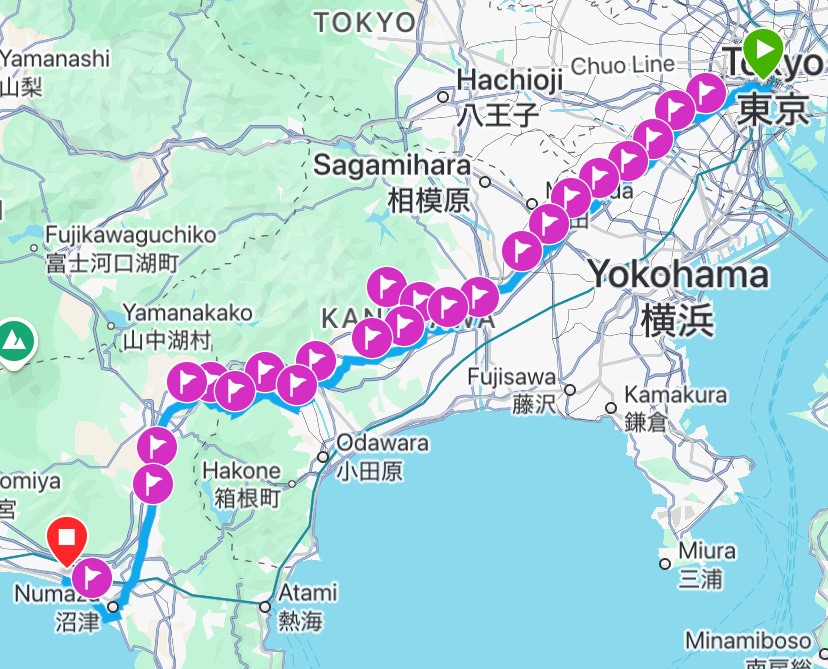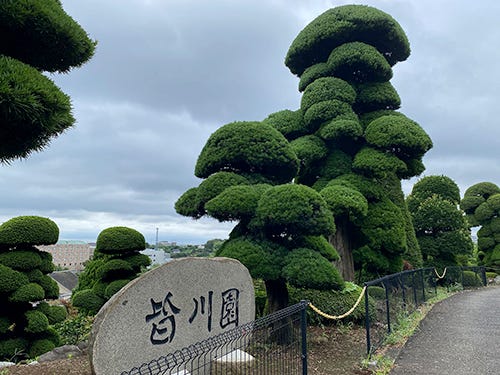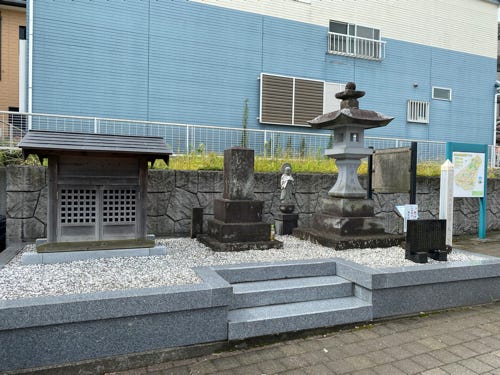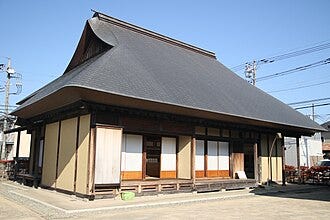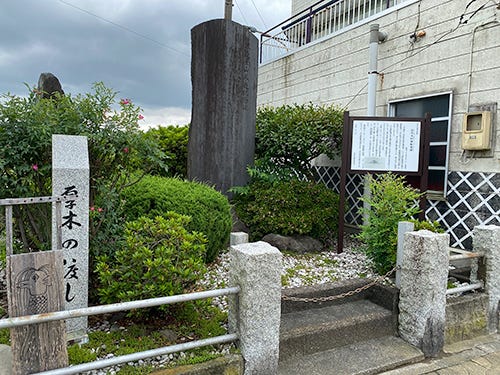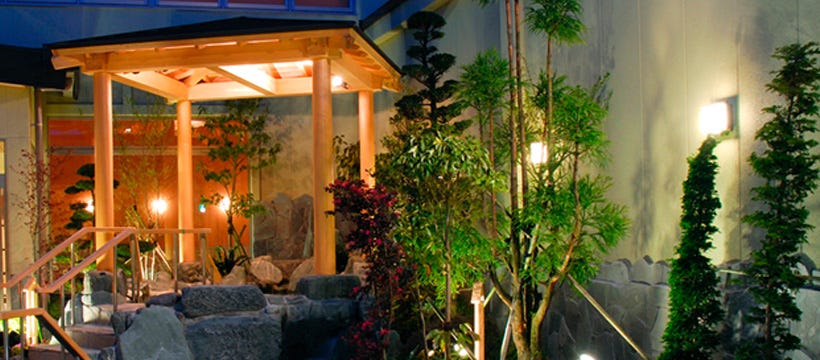Exploring the Yagurazawa Highway
Reference material for a run on April 12-13, 2025
矢倉沢往還 (Yagurazawa Ōkan)
On April 12th to 13th 2025, I plan to run the length of the Yagurazawa highway in one go. There is not a lot of information about this in English so I’m going to piece together what I can find and explain the route here before setting off.
The Yagurazawa highway was developed during the Edo period to connect the Akasaka Gate of Edo Castle (now the imperial palace in Tokyo), to Numazu-Juku in Shizuoka prefecture. It serves as a pilgrimage route from Edo to Mt Ōyama and currently runs along National Route 246 [1].
The event I am entering is a 100 mile (160 km) ultramarathon along the length of the highway with the 2025 event going from Tokyo to Numazu.
The check points on the course are all historic points on the Yagurazawa highway. I took information from the organizers website [2] and roughly translated the info, in addition to adding some of my own information.
日比谷公園 Hibiya Park (0 km) - Start point
Hibiya park is the park next to the imperial palace in Tokyo. I need to go over there in the morning to pick up a race packet, drop off a waiver and then set off on the run.
I will leave my luggage here and I am also allowed to leave a drop bag which I will be able to access at the 92.5 km aid station.
世田谷代官屋敷門 Setagaya Daikan Yashiki Gate (12.8 km) - Check point 1
The only one of its kind in Tokyo as the residence of a daimyo. The first national “Important Cultural Property” in Tokyo.
大山小径 Ōyama Koji (18.5 km)- Check point 2
Tile paintings showing the road to Ōyama, based on the Edo period's “Shinita Orai Sugoroku” (a book about the Edo period).
皆川園上 Minagawa-en(24.9km)- Check point 3
This is Minagawa-en is a former a rest stop (立て場) of the Minagawa Family on the road to Oyama.
下宿常夜灯 Shimojyuku Jyoyo Lantern(34.2km)- Check point 4
Built by Ōyama Koju at Nagatsuta-juku, about 9 ri* from Edo (Akasaka Gate).
*Note: Ri (里) is an old unit of measurement equaling 3.92727 km.
下鶴間ふるさと館 Shimotsuruma Furusatokan (39.7 km) - Aid station 1
First aid station on the course. The Shimotsuruma Furusatokan [3] is a building belonging to the Ogura family. It had some history of being a post office, which is likely why it was included as an aid station/check point on the course.
Aid station food: Assorted breads
厚木の渡しAtsugi no Watashi (51.7km) - Check point 5
A ferry crossing point over the Sagami River called “Atsugi no Watashi.” (渡船場 (tosenba): Ferry crossing point)
丸山城址公園 Maruyama Castle Site Park (60.4 km) - Aid station 2
The former site of Maruyama Castle in Isehara [4]. Now a playground. This is the second aid station on the course. 100 km to go.
Aid station food: 肉うどん (Meat udon)
大山阿夫利神社下社 Oyama Afuri Shrine (69.7km) - Check point 6
A place of prayer for the longevity of military fortune, more than 200,000 people have made the “Ōyama Pilgrimage” every year since the Edo period (1603-1868).
This is not the first time I have been to this shrine. I once ran here from Oiso beach during the Aobato Trail Run and I frequently take visitors to this shrine. There is a cable car that can take you to this shrine, but of course, I’ll not be using that on this run. Note that this shrine is the lower shrine (下社), with the upper shrine being on the peak of Ōyama.
富士見塚 Fujimizuka mound (92.5 km) - Aid station 3
Fujimi means “View of Fuji.” If conditions are good I may be able to get a good view of Mt Fuji. When I consider this is 92.5 km in and this is only the third aid station I wonder what I’ve signed up for. (This is the area where I will be able to access my drop bag so I’ll likely get my stuff ready for the night portion of the run here).
Aid station food: Beef curry
足柄峠 Ashigara Pass (113.0 km) - Aid station 4
The Ashigara Pass is a mountain pass at the border of Kanagawa and Shizuoka [5]. The picture here shows a nice view but this part will be during the night. I should also point out that this is likely the part of the course with the most elevation so I’m expecting this part to be pretty tough.
Aid station food: Cream stew
富士岡公園 Fujioka Park (130.2 km) - Aid station 5
Fujioka park is a simple park in Gotemba [6]. It’s less than 20km after the previous aid station and most of the run seems to be downhill from the Ashigara Pass. That might mean it won’t take long to get there, but it might also mean my legs are destroyed.
Aid station food: Pork soup
港口公園 Minatoguchi Park (152.0 km) - Aid station 6
This looks like quite a pleasant park right next to the sea [7].
Aid station food: Tofu soup
天然温泉ざぶ~ん Natural Hot Spring Zabu~n (160.2 km) - Goal
The 100 mile mark and goal! This hot spring looks like it will be very pleasant [8]. The day after the last ultra I ran I went to a hot spring like this and almost passed out. I’ll try not to do that this time but I’m sure it will be exactly what is needed after a 100 mile run.
Final thoughts
The time limit for this run is 33 hours 33 minutes. That’s plenty of time to deal with whatever might happen during the run.
Based on my experience with ultra running I feel like it’s important to pay attention to the elevation plot and manage your effort based on that. If you don’t know how high a hill is and you just decided to run up it, you may find yourself totally exhausted at the top only to find a much bigger hill in front of you. This is an endurance event, not a race.
My strategy for this run is going to be to run at a pace where I don’t exert myself too much up until the Maruyama Castle Site Park(60.4 km) Aid station, then hike to Ōyama Afuri Shrine (69.7km). I know from experience this is going to be a pretty tough climb. After I come down that mountain, jogging to 富士見塚 Fujimizuka mound (92.5 km) seems reasonable, and then I’ll hike up to Ashigara Pass (113.0 km). After Ashigara Pass it will be more or less all downhill until the end.
This course only has 2,355 m of ascent over 160 km. When I ran the Izu Trail Journey there was 3,242 meters of ascent over 70 km, so in comparison, this is less extreme. I’m going to think positive about this and just “power hike” during those two big ascents. I think one of the things I really need to watch out for is not destroying my quads on the first big descent from Afuri Shrine.
The week before the race I am going to be kicking back. I’ll do some active recovery but recovery will be the main theme. I’ve never run 100 miles before so I just want to be able to complete this. The journey really is going to be the reward here.
Ganbarimasu.
Thank you very much for reading. If you enjoy my work please share it with someone you think would also enjoy it.
If you aren’t subscribed, please sign up to keep up to date.
If social media is more your thing I’m active on Facebook, Twitter, and Instagram.
And if you are looking for ways you can support my work please check out the page below:
Osu!
Anthony


